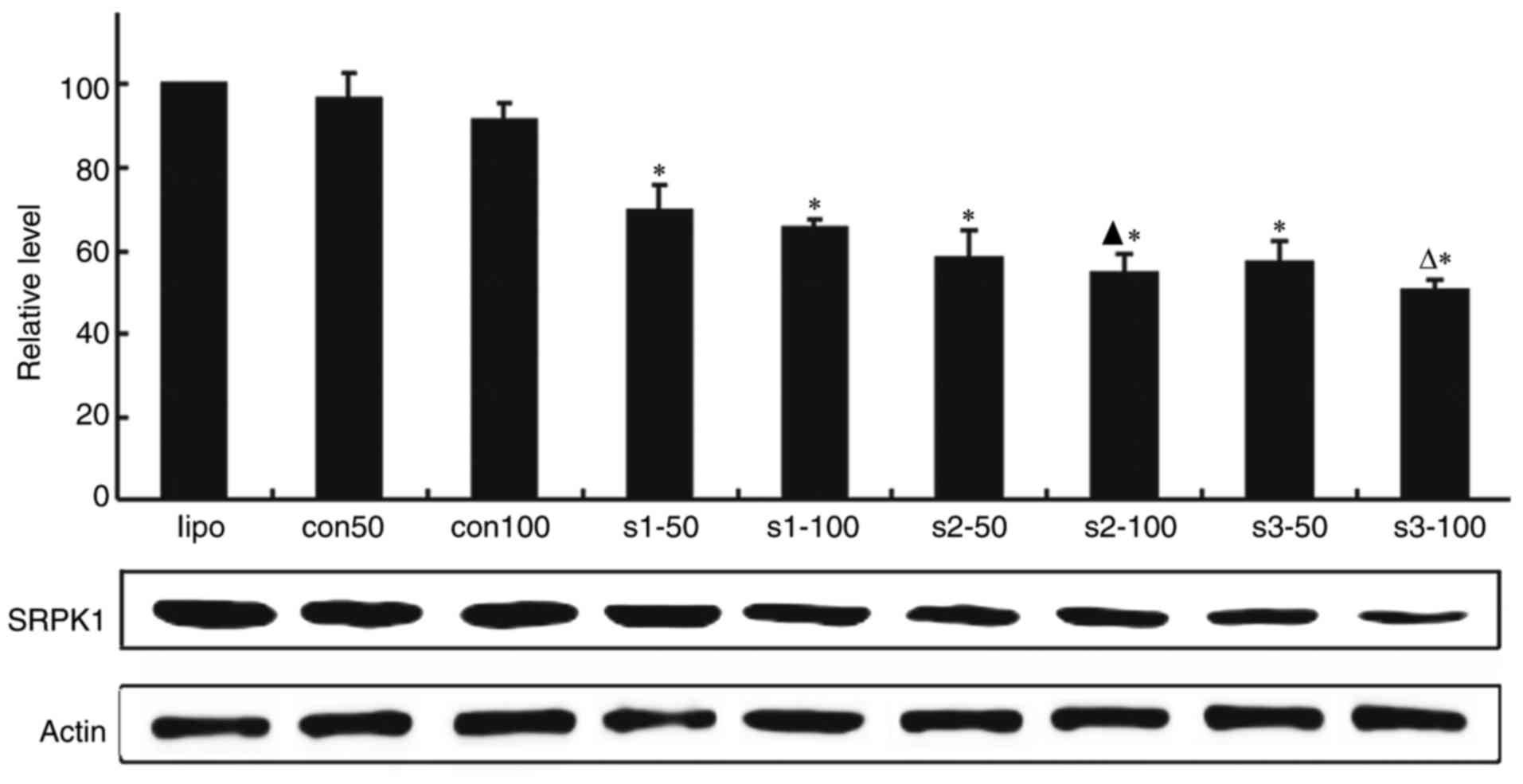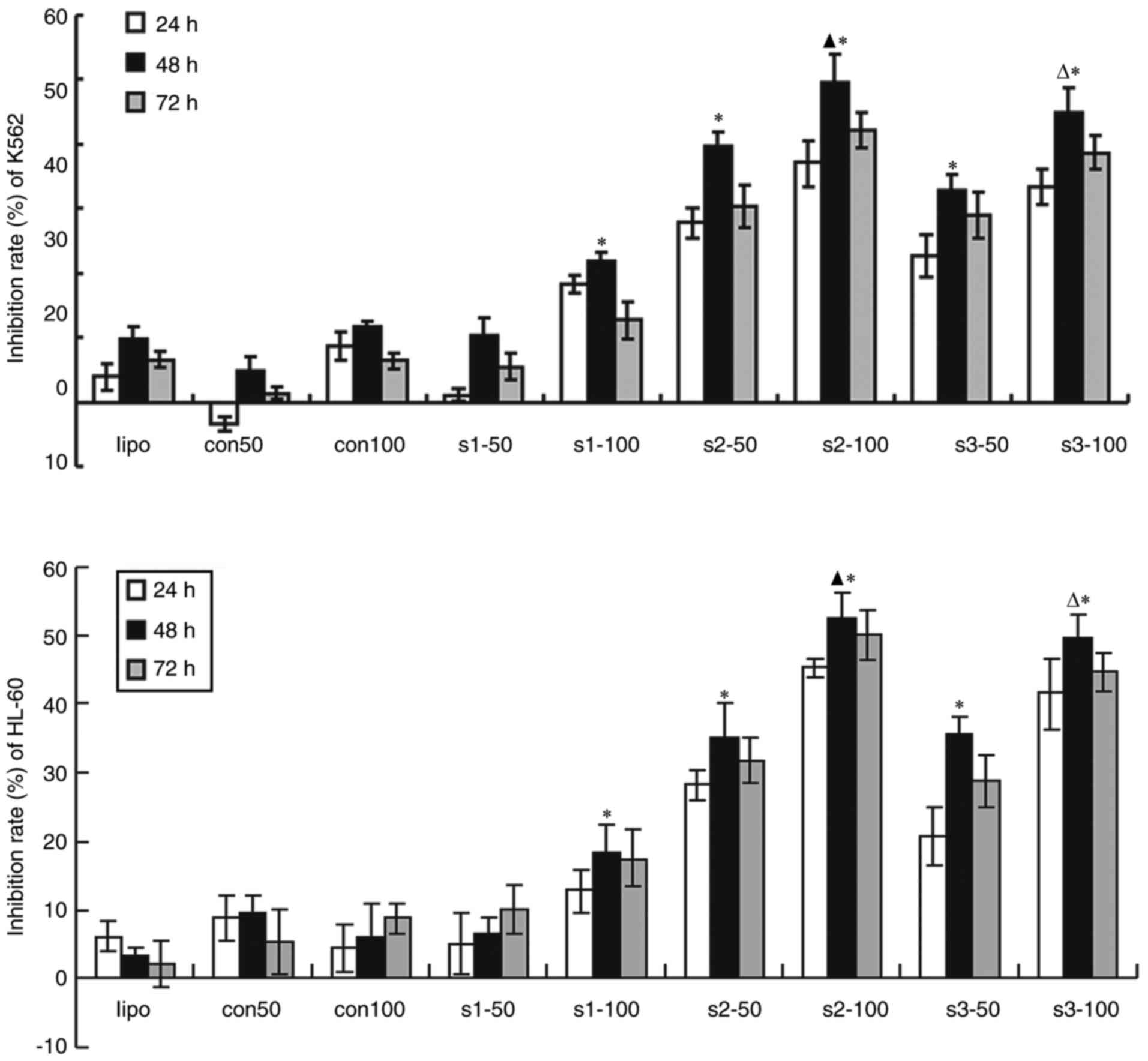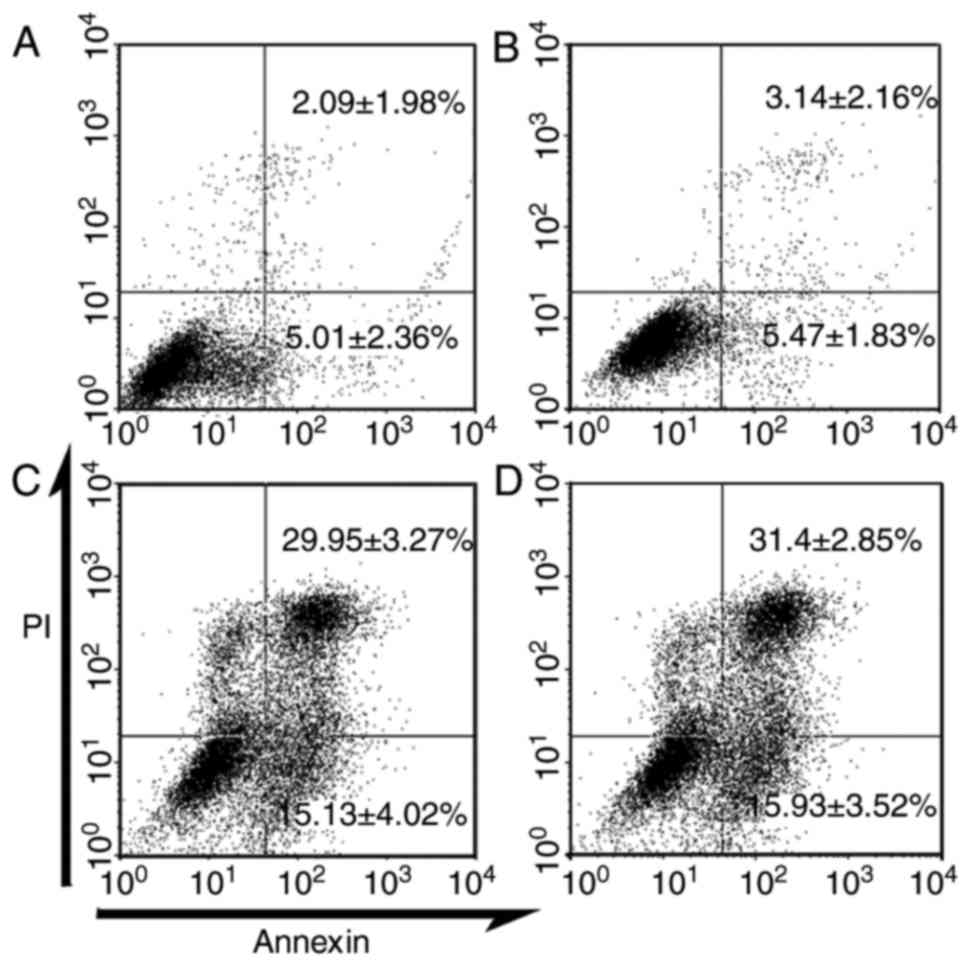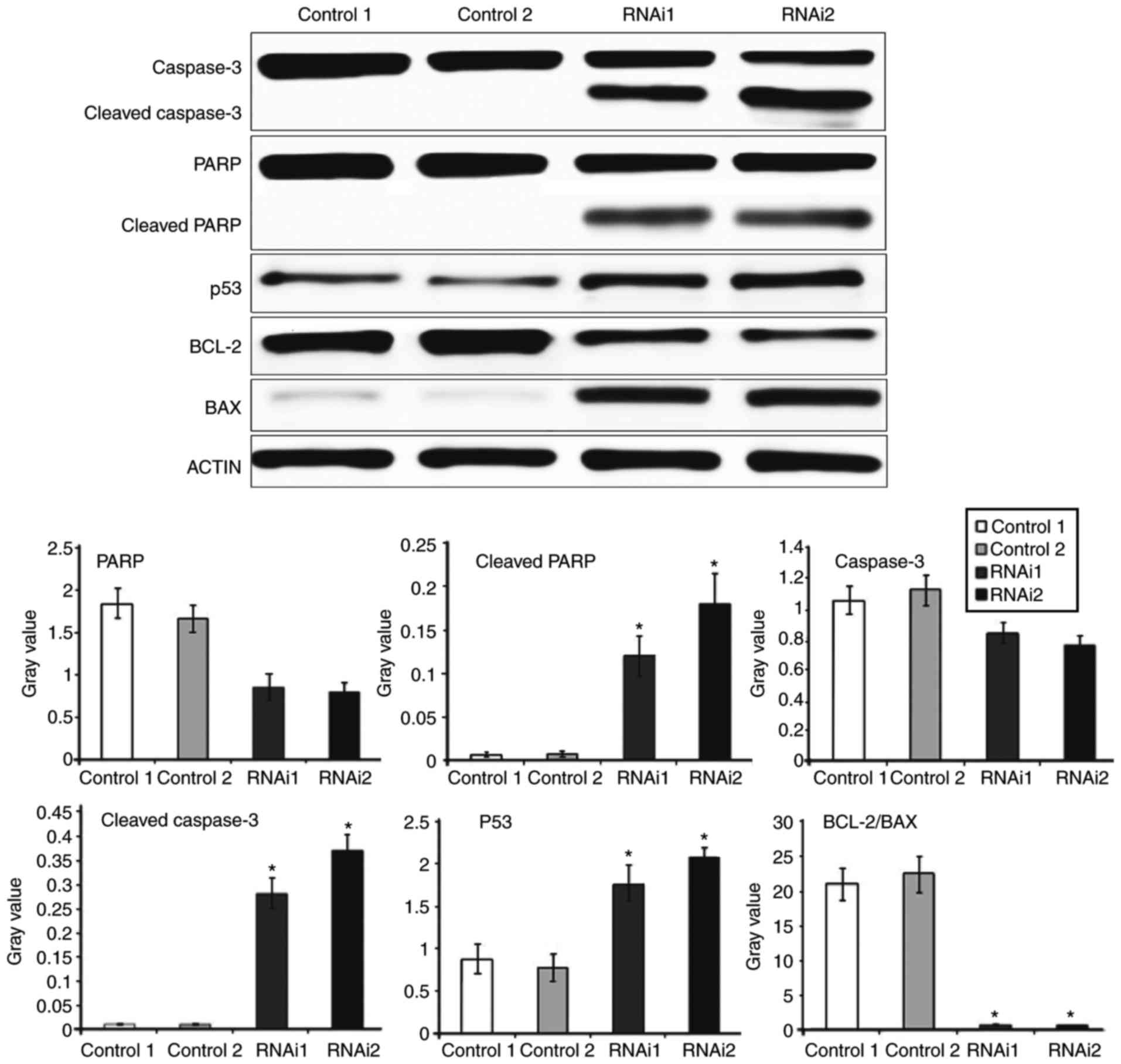|
1
|
Ding JH, Zhong XY, Hagopian JC, Cruz MM,
Ghosh G, Feramisco J, Adams JA and Fu XD: Regulated cellular
partitioning of SR protein-specific kinases in mammalian cells. Mol
Biol Cell. 17:876–885. 2006. View Article : Google Scholar :
|
|
2
|
Ngo JC, Chakrabarti S, Ding JH,
Velazquez-Dones A, Nolen B, Aubol BE, Adams JA, Fu XD and Ghosh G:
Interplay between SRPK and Clk/Sty kinases in phosphorylation of
the splicing factor ASF/SF2 is regulated by a docking motif in
ASF/SF2. Mol Cell. 20:77–89. 2005. View Article : Google Scholar
|
|
3
|
Mavrou A, Brakspear K, Hamdollah-zadeh M,
Damodaran G, Babaei-Jadidi R, Oxley J, Gillatt DA, Ladomery MR,
Harper SJ, Bates DO and Oltean S: Serine-arginine protein kinase 1
(SRPK1) inhibition as a potential novel targeted therapeutic
strategy in prostate cancer. Oncogene. 34:4311–4319. 2015.
View Article : Google Scholar
|
|
4
|
Hayes GM, Carrigan PE, Beck AM and Miller
LJ: Targeting the RNA splicing machinery as a novel treatment
strategy for pancreatic carcinoma. Cancer Res. 66:3819–3827. 2006.
View Article : Google Scholar
|
|
5
|
Hayes GM, Carrigan PE and Miller LJ:
Serine-arginine protein kinase 1 overexpression is associated with
tumorigenic imbalance in mitogen-activated protein kinase pathways
in breast, colonic, and pancreatic carcinomas. Cancer Res.
67:2072–2080. 2007. View Article : Google Scholar
|
|
6
|
Lassus P, Opitz-Araya X and Lazebnik Y:
Requirement for caspase-2 in stress-induced apoptosis before
mitochondrial permeabilization. Science. 297:1352–1354. 2002.
View Article : Google Scholar
|
|
7
|
Wurzer WJ, Planz O, Ehrhardt C, Giner M,
Silberzahn T, Pleschka S and Ludwig S: Caspase 3 activation is
essential for efficient influenza virus propagation. EMBO J.
22:2717–2728. 2003. View Article : Google Scholar :
|
|
8
|
Chun HJ, Zheng L, Ahmad M, Wang J, Speirs
CK, Siegel RM, Dale JK, Puck J, Davis J, Hall CG, et al:
Pleiotropic defects in lymphocyte activation caused by caspase-8
mutations lead to human immunodeficiency. Nature. 419:395–399.
2002. View Article : Google Scholar
|
|
9
|
Song E, Lee SK, Wang J, Ince N, Ouyang N,
Min J, Chen J, Shankar P and Lieberman J: RNA interference
targeting Fas protects mice from fulminant hepatitis. Nat Med.
9:347–351. 2003. View
Article : Google Scholar
|
|
10
|
Liu J, Liu J, Mao J, Yuan X, Lin Z and Li
Y: Caspase-3-mediated cyclic stretch-induced myoblast apoptosis via
a Fas/FasL-independent signaling pathway during myogenesis. J Cell
Biochem. 107:834–844. 2009. View Article : Google Scholar
|
|
11
|
Jiang J, Qi YX, Zhang P, Gu WT, Yan ZQ,
Shen BR, Yao QP, Kong H, Chien S and Jiang ZL: Involvement of Rab28
in NF-κB nuclear transport in endothelial cells. PLoS One.
8:e560762013. View Article : Google Scholar :
|
|
12
|
Rennier K and Ji JY: Effect of shear
stress and substrate on endothelial DAPK expression, caspase
activity, and apoptosis. BMC Res Notes. 6:102013. View Article : Google Scholar :
|
|
13
|
Xu C, Hao Y, Wei B, Ma J, Li J, Huang Q
and Zhang F: Apoptotic gene expression by human periodontal
ligament cells following cyclic stretch. J Periodontal Res.
46:742–748. 2011. View Article : Google Scholar
|
|
14
|
Medina V, Edmonds B, Young GP, James R,
Appleton S and Zalewski PD: Induction of caspase-3 protease
activity and apoptosis by butyrate and trichostatin A (inhibitors
of histone deacetylase): Dependence on protein synthesis and
synergy with a mitochondrial/cytochrome c-dependent pathway.
Cancer Res. 57:3697–3707. 1997.
|
|
15
|
Forment J, Mulet JM, Vicente O and Serrano
R: The yeast SR protein kinase Sky1p modulates salt tolerance,
membrane potential and the Trk1,2 potassium transporter. Biochim
Biophys Acta. 1565:36–40. 2002. View Article : Google Scholar
|
|
16
|
Kondoh H, Yuasa T and Yanagida M: Mis3
with a conserved RNA binding motif is essential for ribosome
biogenesis and implicated in the start of cell growth and S phase
checkpoint. Genes Cells. 5:525–541. 2000. View Article : Google Scholar
|
|
17
|
Kamachi M, Le TM, Kim SJ, Geiger ME,
Anderson P and Utz PJ: Human autoimmune sera as molecular probes
for the identification of an autoantigen kinase signaling pathway.
J Exp Med. 196:1213–1225. 2002. View Article : Google Scholar :
|
|
18
|
Mavrou A, Brakspear K, Hamdollah-Zadeh M,
Damodaran G, Babaei-Jadidi R, Oxley J, Gillatt DA, Ladomery MR,
Harper SJ, Bates DO and Oltean S: Serine arginine protein kinase 1
(SRPK1) inhibition as a potential novel targeted therapeutic
strategy in prostate cancer. Oncogene. 34:4311–4319. 2015.
View Article : Google Scholar
|
|
19
|
Lin JC, Lin CY, Tarn WY and Li FY:
Elevated SRPK1 lessens apoptosis in breast cancer cells through
RBM4-regulated splicing events. RNA. 20:1621–1631. 2014. View Article : Google Scholar :
|
|
20
|
Hu ZY, Wang XY, Guo WB, Xie LY, Huang YQ,
Liu YP, Xiao LW, Li SN, Zhu HF, Li ZG and Kan H: Long non-coding
RNA MALAT1 increases AKAP-9 expression by promoting SRPK1-catalyzed
SRSF1 phosphorylation in colorectal cancer cells. Oncotarget.
7:11733–11743. 2016. View Article : Google Scholar :
|
|
21
|
Liu H, Hu X, Zhu Y, Jiang G and Chen S:
Up-regulation of SRPK1 in non-small cell lung cancer promotes the
growth and migration of cancer cells. Tumour Biol. 37:7287–7293.
2016. View Article : Google Scholar
|
|
22
|
Sanidas I, Kotoula V, Ritou E, Daans J,
Lenz C, Mairhofer M, Daniilidou M, Kolbus A, Kruft V, Ponsaerts P
and Nikolakaki E: The ratio of SRPK1/SRPK1a regulates erythroid
differentiation in K562 leukaemic cells. Biochim Biophys Acta.
1803:1319–1331. 2010. View Article : Google Scholar
|
|
23
|
Wu Q, Chang Y, Zhang L, Zhang Y, Tian T,
Feng G, Zhou S, Zheng Q, Han F and Huang F: SRPK1 dissimilarly
impacts on the growth, metastasis, chemosensitivity and
angiogenesis of glioma in normoxic and hypoxic conditions. J
Cancer. 4:727–735. 2013. View
Article : Google Scholar :
|
|
24
|
van Roosmalen W, Le Dévédec SE, Golani O,
Smid M, Pulyakhina I, Timmermans AM, Look MP, Zi D, Pont C, de
Graauw M, et al: Tumor cell migration screen identifies SRPK1 as
breast cancer metastasis determinant. J Clin Invest. 125:1648–1664.
2015. View
Article : Google Scholar :
|
|
25
|
Wang P, Zhou Z, Hu A, de Albuquerque Ponte
C, Zhou Y, Hong L, Sierecki E, Ajiro M, Kruhlak M, Harris C, et al:
Both decreased and increased SRPK1 levels promote cancer by
interfering with PHLPP-mediated dephosphorylation of Akt. Mol Cell.
54:378–391. 2014. View Article : Google Scholar :
|
|
26
|
Ren G, Sheng L, Liu H, Sun Y, An Y and Li
Y: The crucial role of SRPK1 in TGF-β-induced proliferation and
apoptosis in the esophageal squamous cell carcinomas. Med Oncol.
32:2092015. View Article : Google Scholar
|
|
27
|
Sigala I, Tsamis KI, Gousia A, Alexiou G,
Voulgaris S, Giannakouros T, Kyritsis AP and Nikolakaki E:
Expression of SRPK1 in gliomas and its role in glioma cell lines
viability. Tumour Biol. 37:8699–8707. 2016. View Article : Google Scholar
|
|
28
|
Decker P and Muller S: Modulating poly
(ADP-ribose) polymerase activity: Potential for the prevention and
therapy of pathogenic situations involving DNA damage and oxidative
stress. Curr Pharm Biotechnol. 3:275–283. 2002. View Article : Google Scholar
|
|
29
|
Bellodi C, Kopmar N and Ruggero D:
Deregulation of oncogene-induced senescence and p53 translational
control in X-linked dyskeratosis congenita. EMBO J. 29:1865–1876.
2010. View Article : Google Scholar :
|
|
30
|
Elkholi R and Chipuk JE: How do I kill
thee? Let me count the ways: p53 regulates PARP-1 dependent
necrosis. Bioessays. 36:46–51. 2014. View Article : Google Scholar
|














